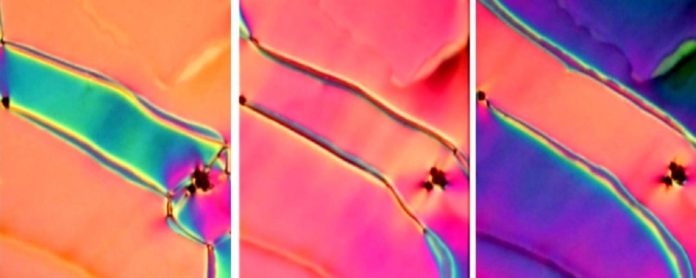Scientists at the University of Colorado Boulder’s Soft Materials Research Center (SMRC) have discovered an elusive phase of matter. The discovery describes the discovery “ferroelectric nematic” phase of liquid crystal.
Predicted by Debye and Born 100 y ago and since revisited extensively, in systems ranging from colloidal suspensions of rods or discs to melts of polar molecules, the existence of the ferroelectric nematic has never been certain.
Nematic liquid crystals’ materials exhibit a curious mix of fluid and solid like behaviors, which permit them to control light. Specialists have utilized them broadly to make the liquid crystal displays (LCDs) in numerous laptops, TVs, and cellphones.
A ferroelectric nematic liquid crystal phase is much more disciplined. In such a liquid crystal, patches or “domains” form in the sample in which the molecules all point a similar direction, either right or left. In physics parlance, these materials have polar ordering.
Noel Clark, a professor of physics and director of the SMRC, said that “the discovery of one such liquid crystal could open up a wealth of technological innovations—from new types of display screens to reimagined computer memory.”
“There are 40,000 research papers on nematics, and in almost any one of them, you see interesting new possibilities if the nematic had been ferroelectric.”
1n 1910, Nobel Laureates Peter Debye and Max Born suggested that if you designed a liquid crystal correctly, its molecules could spontaneously fall into a polar ordered state. Since then, scientists started to discover solid crystals that did something similar: Their molecules pointed in uniform directions. They could also be reversed, flipping from right to left or vice versa under an applied electric field. These solid crystals were called “ferroelectrics” because of their similarities to magnets.
Later on, scientists struggled to discover the liquid crystal phase with similar properties. That is until Clark, and his partners started analyzing RM734, an organic molecule created by a group of British scientists several years ago. Scientists reported that RM734 exhibited a conventional nematic liquid crystal phase at higher temperatures. At lower temperatures, another unusual phase appeared.
When scientists observed that strange phase using a microscope, they observed that a palette of striking colors developed toward the edges of the cell containing the liquid crystal under a weak electric field.
After conducting several experiments, scientists discovered that this phase of RM734 was 100 to 1,000 times more responsive to electric fields than the usual nematic liquid crystals. It means the molecules that make up the liquid crystal demonstrated strong polar order.
Clark said, “When the molecules are all pointing to the left, and they all see a field that says, ‘go right,’ the response is dramatic. The team also discovered that distinct domains seemed to form spontaneously in the liquid crystal when it cooled from higher temperatures. There were, in other words, patches within their sample in which the molecules seemed to be aligned.”
“That confirmed that this phase was, indeed, a ferroelectric nematic fluid.”
Joe MacLennan, a study co-author and a professor of physics at CU Boulder, said, “Entropy reigns in a fluid. Everything is wiggling around, so we expected a lot of disorder.”
“When the researchers examined how well aligned the molecules were inside a single domain, we were stunned by the result. The molecules were nearly all pointing in the same direction.”
In future research, scientists will determine how RM734 achieves this rare feat. They are planning to use computer simulation to tackle this question.
Clark said, “This work suggests that other ferroelectric fluids are hiding in plain sight. It is exciting that right now, techniques like artificial intelligence are emerging that will enable an efficient search for them.”
Journal Reference:
- Xi Chen, First-principles experimental demonstration of ferroelectricity in a thermotropic nematic liquid crystal: Polar domains and striking electro-optics. DOI: 10.1073/pnas.2002290117
